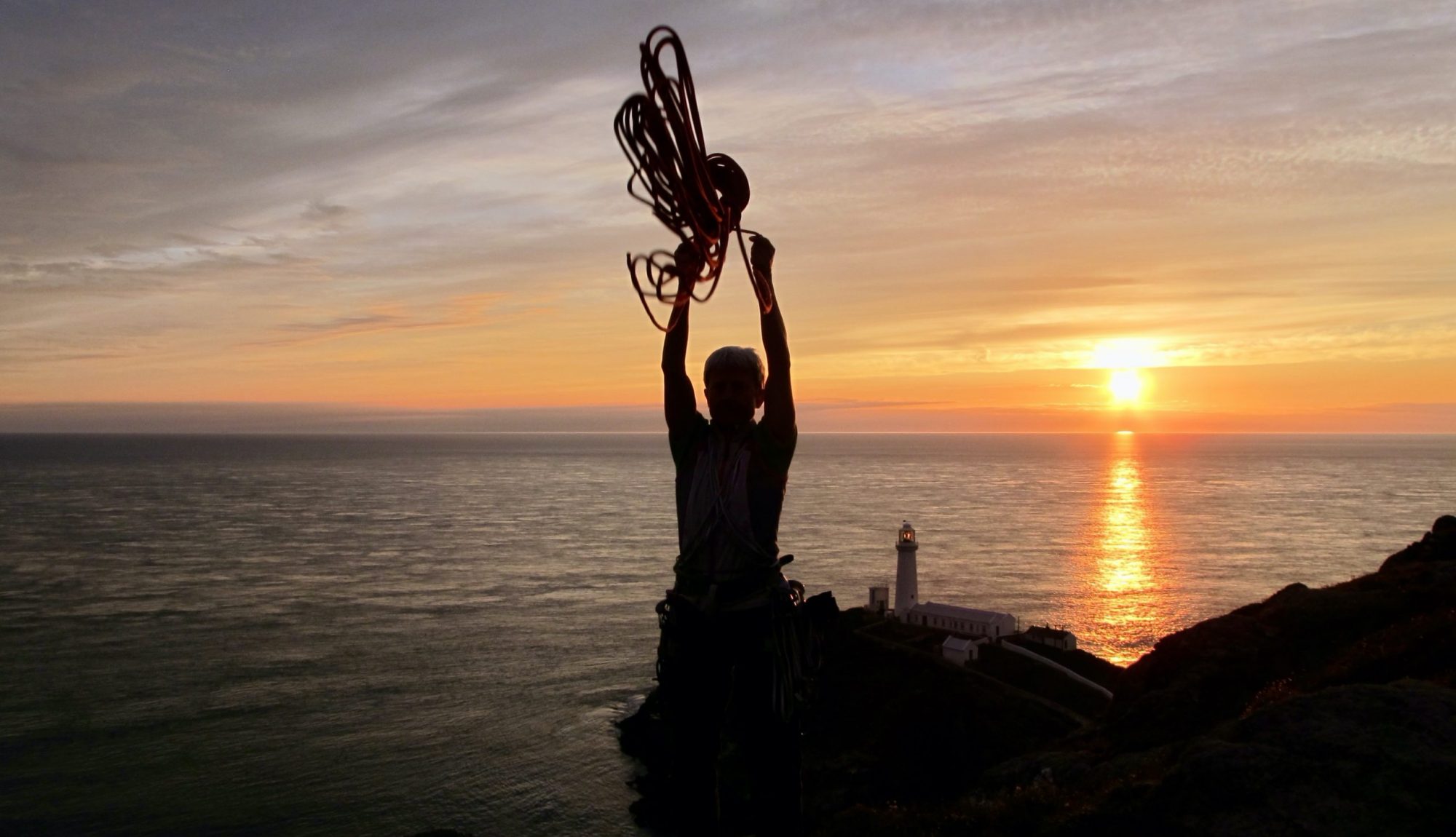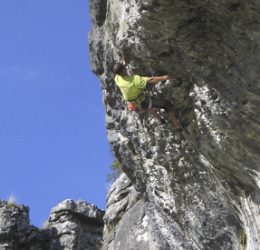
Chullila January 2013. I watched with admiration as Hazel took yet another fall as she worked her way up one of the desperate looking 8b’s at the far end of the crag. There was no fuss or screams, just a graceful flight through the air before she pulled back on and had another go. The next day she was onsighting hard route after hard route. If she didn’t manage the OS it would be dispatched next go, then she would move along onto the next route. I was also climbing well that winter, with my first few 8a onsights under my belt and redpoints of several 8bs, yet watching Hazel made me even more aware of my own limitations. I tended to climb mainly within my comfort zone, being drawn to endurance routes that weren’t too steep, allowing me plenty of time to climb up and down before committing to a sequence. I also tended to work harder routes on a top-rope first before taking on the lead. Deep down I knew I had several reasons for this – fear of falling, fear of failing, fear of commitment and lack of self-belief, all of which conspired together to hold me back. A lot of the time this wasn’t evident, run-outs when I felt in control didn’t bother me but faced with a committing move such as a jump or slap and I would hesitate and usually end up sitting on the rope. I suffered from irrational thoughts in these situations that my belayer would drop me (even on a top rope sometimes). I also performed poorly on very steep routes where quick decisions are generally needed and faffing about like I did usually resulted in failure. I still have a list of routes that I have ‘saved’ for another day when I might be feeling stronger, braver, fitter, etc in the hope that I could onsight them.
Watching Hazel though inspired me to start making some changes. Over the past two years I’ve gradually started to work on these issues with some success. Firstly I started to lead the warm-ups, rather than often top-roping them. I also decided to work the harder routes on the lead, which worked really well. Several climbers had recommended reading The Rock Warriors Way by Arno Ilgner, so I downloaded it and started working my way through it. Too be honest, although some of it was really interesting there also seemed to be plenty of waffle and I haven’t yet finished it. However, it did get me really thinking. I discovered I was definitely more of an analytical climber than an intuitive climber; decided I needed to set smaller, more achievable goals; and had to start looking for a positive in every performance instead of dwelling on failure and letting that dictate my mood. I also learnt about my ego and how that may have been holding me back in certain circumstances. With all this in mind I got back on routes that I’d dismissed in the past as being too hard or too reachy or not my style. I worked on climbing quicker and more fluidly on the bouldering wall, and tried more dynamic problems which I would have previously ignored. I sought out steeper routes on holiday that really pushed me both mentally and physically. If I was just concerned with the numbers game this could have been disheartening as I struggled with routes given a lesser grade than ones I’d previously succeeded on. However, I tried not to reflect on that and instead looked at all the positives. Over those two years I managed to tick off numerous outstanding projects, both in the UK and abroad and managed to surprise myself with both onsights and redpoints of routes that I would have avoided previously. However, I knew I still held back at times and this was highlighted by my failure on a route I’d saved for many years, hoping to onsight it. I found the start of the route harder than expected and this shocked me mentally, putting me on a back foot straight away and I started to doubt my ability. This was compounded when I got to a long, committing move. The route was very steep, not one for hanging around on, but hang around I did! Up and down, round and around looking for an alternative method, trying to shake out but getting more and more tired, ripping the skin on both my hands and my heel as I tried to recover. I’d saved this route for so long I didn’t want to blow it by falling off this move. In the end I had to commit, I made the move but was so exhausted I slumped off a few moves later. I then had to rest a few more times to get to the belay and was too knackered for a redpoint attempt. Initially I was upset and frustrated with myself, but decided at least I’d taken the route on in the first place instead of saving it a bit longer. That at the end of the day it was just a line of bolts up an arbitrary piece of rock and it didn’t really matter in the grand scheme of things. I’d also learnt the hard way that procrastination is not the best strategy on that sort of route and that if I really wanted to improve more work was needed on the mental side of my climbing.
Not long after that I was reading Hazel’s Facebook post about the mental side of climbing and how she was toying with the idea of offering some coaching on this subject. I sent her an email and asked if she would be prepared to take me on. I think she was quite surprised but after I reassured her I was genuinely serious she agreed. After filling in a detailed questionnaire that required a high degree of ego crushing honesty and a long chat on the phone we got started. She got straight to the heart of the problem, which is a basic fear of falling and the lack of control this involves. Even on a toprope I found it hard to let go without reassurance first that my belayer had me. If I felt I was in control then I won’t think about it, but as soon as that control was compromised the fear would arise. This could be down to a jump or slap, or committing to a move off a poor handhold or a marginal smear. Suddenly the irrational would take over and it would take an enormous amount of mental energy to make that commitment, and at other times I couldn’t make it at all.
Hazel offered loads of advice and practical exercises to try. She also recommended I read Arno Ilgner’s other book – Expresso Lessons. This was much more interesting and easier to read, I would definitely recommend it to anyone interested in this subject. One of the exercises both Arno and Hazel suggested was fall practice. Now I had tried fall practice in the past but had pushed too hard too soon, which resulted in me getting frustrated and upset at my failure. This time I took it more slowly, doing some falls on the toprope to start with, then moving to the lead, concentrating on my breathing, relaxing. Looking up before letting go instead of down was hard to start with but also easier in some respects, and mimicked the climbing situation much more. I’m slowly progressing, but have a long way to go. I’ve realised that I need to try and incorporate some fall practice into everyday at the crag/wall and have started trying to incorporate it into my warm-up.

So did any of this work? Well I did have numerous successes this year, the main one being my redpoint of Showtime at Kilnsey. Showtime is a 30m 8b with three distinct cruxes none of which suited my usual style! I had looked at this a few years back and dismissed it as being too reachy and therefore impossible. Last year I had a few runs up it to see if I could find another sequence on all three cruxes, all of which, on the face of it, involve very big moves. The first one is very thin face climbing, so by holding some marginal holds I was able to get round the more obvious big moves. The second crux was more complicated, but by doing a big reach and pulling off the intermediate I managed to do the individual moves but couldn’t link it. The last crux was just a massive slap from a small undercut, no way round this unfortunately and I could barely do the move after sitting in the rope, so the thought of doing it after 30m of climbing was quite daunting. However, I’d seen that it could be possible so was looking forward to getting on it this year. I broke the route down into small goals and would have an aim for each session on it. I also did plenty of practice falls. Hazel also offered advice on techniques for maintaining focus which were invaluable once I was on the redpoint. The route came together faster than I thought, although I did spend three days and numerous redpoints falling off that move at the top. Another success in my eyes was my failed onsight of Cockblock, a popular and powerful classic E5 6b in the Llanberis Pass. This may seem like a bit of an oxymoron, however, when you consider that I’ve rarely fallen off a trad route in the past (the few times I have it’s been down to a broken hold, or a sudden slip off a greasy hand or foothold), the fact that I fell off this whilst trying hard was a massive step forward. Previously I have avoided this route as short intense routes with a bouldery and reachy crux are not my forte. Also I have done less trad over the past few years so I wasn’t really trad fit for hanging around placing gear, especially when I wasn’t always getting the right piece of protection first time. Despite this I made the effort to take it on. Needless to say I got really pumped placing the gear but pushed on regardless, fought upwards but unfortunately didn’t quite make the reach and I was off. A quick rest and I got a better sequence, climbed to the top and then red pointed it. Yes I was disappointed not to onsight it, but I was more pleased that I’d actually taken it on in the first place and given everything on it.

I’m now back from a recent trip to Spain. Another two past failures put to bed and success on a route I would never have considered in the past due to its steepness and the ridiculous sequence at the top to get round a big move (I have to admit this did test me as I fell from this move too many times to count – some wise words from Hazel got me up it the next day!). However, the biggest success was the fact that I took more falls this trip than I have on the past few trips put together. This I know is the way forward for me but I don’t find it easy. Just like every other aspect of climbing if you don’t use it you lose it. There is no magic cure, but working on your mental game can be just as rewarding as the physical side. I’m excited to see where it may take me.
A big thank you to Hazel Findley for all her help and advice over the last few months. Thanks must also go to Suzan Dudink for her training advice and of course to Steve Crowe for being such a patient and supportive belayer.

Useful Links:

